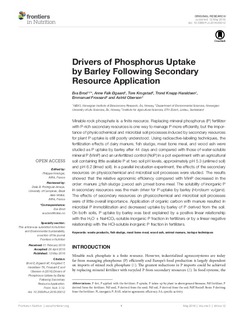| dc.contributor.author | Brod, Eva | |
| dc.contributor.author | Øgaard, Anne K. Falk | |
| dc.contributor.author | Krogstad, Tore | |
| dc.contributor.author | Haraldsen, Trond | |
| dc.contributor.author | Frossard, Emmanuel | |
| dc.contributor.author | Oberson, Astrid | |
| dc.date.accessioned | 2017-09-01T13:17:50Z | |
| dc.date.available | 2017-09-01T13:17:50Z | |
| dc.date.created | 2016-08-03T11:03:55Z | |
| dc.date.issued | 2016 | |
| dc.identifier.citation | Frontiers in Nutrition. 2016, 3 . | nb_NO |
| dc.identifier.issn | 2296-861X | |
| dc.identifier.uri | http://hdl.handle.net/11250/2452838 | |
| dc.description.abstract | Minable rock phosphate is a finite resource. Replacing mineral phosphorus (P) fertilizer with P-rich secondary resources is one way to manage P more efficiently, but the importance of physicochemical and microbial soil processes induced by secondary resources for plant P uptake is still poorly understood. Using radioactive-labeling techniques, the fertilization effects of dairy manure, fish sludge, meat bone meal, and wood ash were studied as P uptake by barley after 44 days and compared with those of water-soluble mineral P (MinP) and an unfertilized control (NoP) in a pot experiment with an agricultural soil containing little available P at two soil pH levels, approximately pH 5.3 (unlimed soil) and pH 6.2 (limed soil). In a parallel incubation experiment, the effects of the secondary resources on physicochemical and microbial soil processes were studied. The results showed that the relative agronomic efficiency compared with MinP decreased in the order: manure ≥fish sludge ≥wood ash ≥meat bone meal. The solubility of inorganic P in secondary resources was the main driver for P uptake by barley (Hordeum vulgare). The effects of secondary resources on physicochemical and microbial soil processes were of little overall importance. Application of organic carbon with manure resulted in microbial P immobilization and decreased uptake by barley of P derived from the soil. On both soils, P uptake by barley was best explained by a positive linear relationship with the H2O + NaHCO3-soluble inorganic P fraction in fertilizers or by a linear negative relationship with the HCl-soluble inorganic P fraction in fertilizers. | nb_NO |
| dc.language.iso | eng | nb_NO |
| dc.rights | Navngivelse 4.0 Internasjonal | * |
| dc.rights.uri | http://creativecommons.org/licenses/by/4.0/deed.no | * |
| dc.title | Drivers of Phosphorus Uptake by Barley Following Secondary Resource Application | nb_NO |
| dc.type | Academic article | nb_NO |
| dc.source.pagenumber | 13 | nb_NO |
| dc.source.volume | 3 | nb_NO |
| dc.source.journal | Frontiers in Nutrition | nb_NO |
| dc.identifier.doi | 10.3389/fnut.2016.00012 | |
| dc.identifier.cristin | 1370223 | |
| cristin.unitcode | 192,1,2,0 | |
| cristin.unitname | Institutt for miljøvitenskap | |
| cristin.ispublished | true | |
| cristin.fulltext | original | |
| cristin.qualitycode | 0 | |

